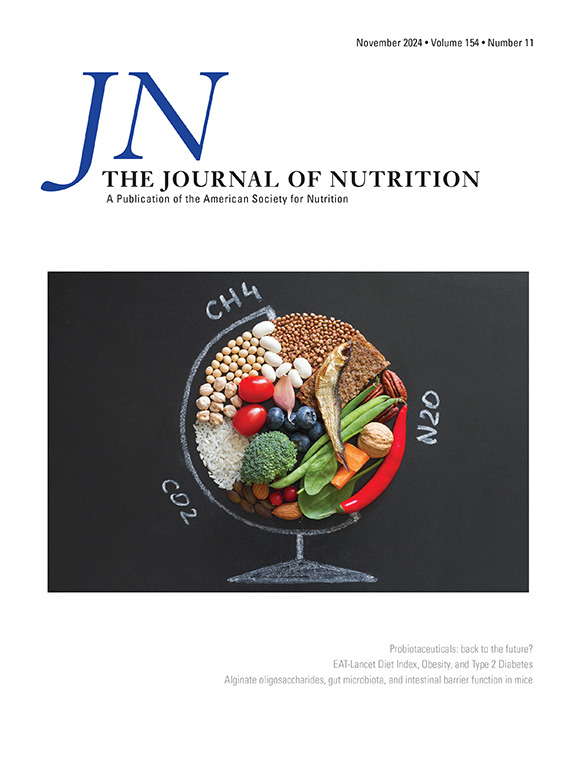Two a Priori Dietary Indices among Young Children in the Children’s Healthy Living (CHL) Trial: Validation and Association with Health Outcomes
IF 3.7
3区 医学
Q2 NUTRITION & DIETETICS
引用次数: 0
Abstract
Background
Children’s diets affect multiple health outcomes. Dietary indices are a useful tool for quantifying the quality of the overall diet, but their performance may differ among children of different ages and in understudied populations.
Objectives
This analysis aimed to validate 2 dietary indices and examine their associations with physical body measures among 2–8-y-old children of the United States-Affiliated Pacific region.
Methods
Data were collected on children (n = 2359) from 5 jurisdictions of the children’s healthy living randomized control trial in independent cross-sectional cluster samples over 3-time points. Anthropometric measurements were taken, and dietary intakes were ascertained from 2 d of dietary records completed by caregivers. The Healthy Eating Index (HEI)-2020 and dietary approaches to stop hypertension (DASH) scores were calculated using a simple scoring algorithm, their construct validity and performance were evaluated, and associations with nutrient intake, body measures, and obesity status were examined using covariate-adjusted means and unconditional logistic regression.
Results
We observed a wide range of variation in DASH (9–38 points) and HEI-2020 (10–94.7 points), clear separation of mean component scores by quintile of the total score, and multiple dimensions for each index. Significant trends in polyunsaturated and saturated fat were observed from the lowest to the highest quintile of HEI-2020 (12% higher and 21% reduction, respectively) but not for DASH. Significant differences by quintile of DASH and HEI-2020 were found for mean body mass index z-score among 6–8-y-olds and for waist circumference among boys and 6–8-y-olds. The odds of obesity exhibited statistically significant downward trends across quintiles of HEI-2020 among all participants and in all sexes and age groups, and across quintiles of DASH among all participants, boys and 6–8-y-olds.
Conclusions
We found that HEI-2020 is a better measure of dietary intake than DASH in this population of 2–8-y-old children of the United States-Affiliated Pacific region.
儿童健康生活(CHL)试验中幼儿的两项先验饮食指标:验证及其与健康结局的关联
背景:儿童饮食影响多种健康结果。膳食指数是量化整体饮食质量的有用工具,但在不同年龄的儿童和未充分研究的人群中,其表现可能有所不同。目的:本分析旨在验证美国附属太平洋地区2-8岁儿童的两项饮食指标,并检查其与身体测量的关系。方法:收集来自儿童健康生活(CHL)随机对照试验5个辖区的儿童(n=2,359)在3个时间点的独立横断面整群样本的数据。进行了人体测量,并从护理人员完成的2天饮食记录中确定了饮食摄入量。采用简单的评分算法计算健康饮食指数(HEI)-2020和饮食方法来停止高血压(DASH)评分,评估其结构效度和性能,并使用协变量校正均值和无条件逻辑回归检验与营养摄入、身体测量和肥胖状况的相关性。结果:我们观察到DASH(9-38分)和HEI-2020(10-94.7分)的变化范围很广,总分五分位数和各指标多维度的平均成分得分分离清晰。在HEI-2020中,从最低五分位数到最高五分位数,多不饱和脂肪和饱和脂肪呈显著趋势(分别增加12%和减少21%),但在DASH中没有明显趋势。6-8岁儿童的平均BMI z-score、男孩和6-8岁儿童的腰围在DASH和HEI-2020的五分位数上存在统计学差异。在HEI-2020的所有参与者、所有性别和年龄组中,肥胖的几率在统计上呈显著下降趋势,在所有参与者、男孩和6-8岁儿童的DASH中,肥胖的几率在统计上也呈显著下降趋势。结论:我们发现,在美国附属太平洋地区的2-8岁儿童人群中,HEI-2020是比DASH更好的饮食摄入指标。
本文章由计算机程序翻译,如有差异,请以英文原文为准。
求助全文
约1分钟内获得全文
求助全文
来源期刊

Journal of Nutrition
医学-营养学
CiteScore
7.60
自引率
4.80%
发文量
260
审稿时长
39 days
期刊介绍:
The Journal of Nutrition (JN/J Nutr) publishes peer-reviewed original research papers covering all aspects of experimental nutrition in humans and other animal species; special articles such as reviews and biographies of prominent nutrition scientists; and issues, opinions, and commentaries on controversial issues in nutrition. Supplements are frequently published to provide extended discussion of topics of special interest.
 求助内容:
求助内容: 应助结果提醒方式:
应助结果提醒方式:


